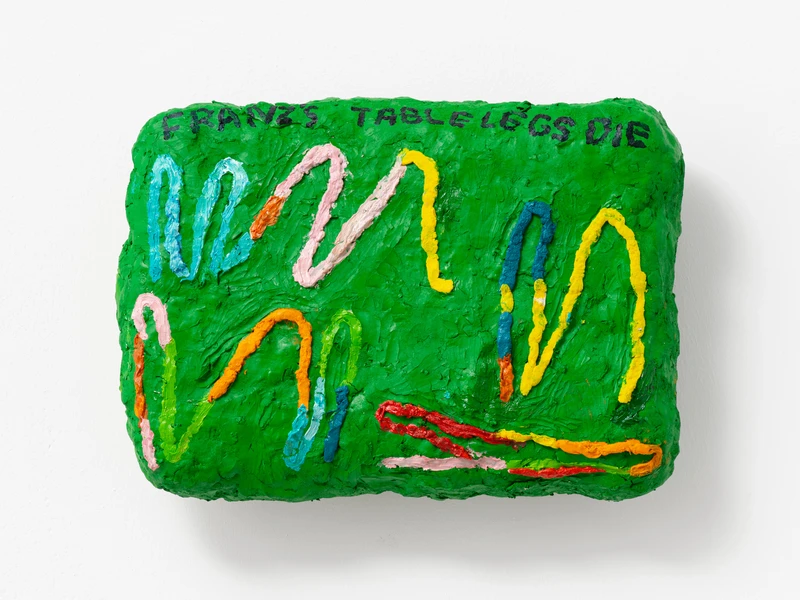Sophie Barber


b. 1996, United Kingdom
Sophie Barber (b. 1996, Hastings, UK) is a painter who draws directly from the world around her, reproducing natural and manmade fragments in an attempt to preserve and process their forms. Depicting tents, bird hides and word games on monumental block-colour canvases, Barber creates surreal, folk-like compositions that are less depictions of her native Sussex coast than distillations of the impression it leaves. ‘Her paintings do not seek to definitively record a singular object or place’, writes critic Philomena Epps of Barber’s recent paintings, ‘they are not about Burwash, Hastings, Bexhill, but rather they elicit a frame of reference or mode of seeing that sets a kind of scene’.
Barber works in the nearby town of Hastings. Upon graduating from University of Brighton at Sussex Coast College Hastings in 2017, she was awarded the CVAN South East Platform Graduate Award, which is run in partnership between Aspex, De La Warr Pavilion, MK Gallery, Modern Art Oxford and Turner Contemporary. Speaking of Barber’s work at the time, Paul Hobson, Director of Modern Art Oxford, noted: ‘We were all struck by the coherence of Sophie’s painting practice and her already confident and distinctive artistic voice.’ In the years since, Barber has continued to refine this voice through numerous solo and group exhibitions – from Goldsmiths CCA, London, to La Maison de Rendez-vous, Brussels – developing an ambitious and dynamic painterly practice that playfully toys with the possibilities of scale, reference and materiality. ‘Her mode of production is spontaneous and unfettered’, writes Epps: ‘representations are edited, distilled, or shown in isolation, with any figuration tending to drift into the realm of the fictional.’
Barber’s paintings exist as aggregations of her immediate surroundings. In her recent solo exhibition at Goldsmiths CCA, ‘The Greatest Song a Songbird Ever Sung’, three monumental canvases combined textual fragments and references to the Sussex coastline with various depictions of shelters: bird hides and dens, heavy tarpaulin tents that corresponded with the unstretched material on which they were rendered. ‘I’m interested in things you can hide in’, says Barber, and this interest in spaces of concealment carries into her broader process: not only does she work with heavy layers of oil, each of which obscures the marks that came before, she also deconstructs the images that she paints, redistributing their components in a manner that obscures their original form. While the 2018 work Puffin at Pett Level does not explicitly depict the titular bird, its colouring is preserved in the red of a tent, a deep black background and the yellow edge of a moon. In Canary Club (2019), the implied yellow of the title is squeezed into a pyramid-like shelter.
‘I’m interested in the weight of things’, Barber has noted, ‘heaviness and things collapsing’. This is an allusion to both the material qualities of her work, the way in which her unstretched canvases crease and slump like oversized clothes on shoulders, and the manner in which she collapses the very images she paints. Rarely is this process of playful reduction as evident as in the miniature works that Barber paints on tightly-wrapped offcuts of recycled canvas. (Barber operates at the extremes of scale; the middle, that which is easily controlled, is uninteresting.) On the irregular surfaces of these impastoed objects, Barber depicts the sculptural forms of such celebrated male gatekeepers as Giotto, Barry Flanagan and, most frequently, Franz West, their monumental public sculptures humorously reduced to squiggles and intentionally slipshod marks. (Flanagan is simply referred to as ‘Barry’; his iconic hare sculptures distilled to splotches of blue.)
These forms are replicated because, as with the tents that populate her larger canvases (‘structures that move with the weather and the world’), they have left such an impression on Barber that she feels compelled to do so. As is illustrated in a recent series of miniatures, onto which she has playfully reproduced the covers of ArtReview magazines that were strewn around her studio, this is repetition as an attempt to resolve, working over as a means to work out why certain forms stick with us. In this, Barber’s is a slow game of processing images: of replicating, reconfiguring and reconsidering visually arresting forms until they reveal themselves to be something other than they were before – or collapse completely, like the pink spirals of a Franz West sculpture or the heavy walls of a circus tent.